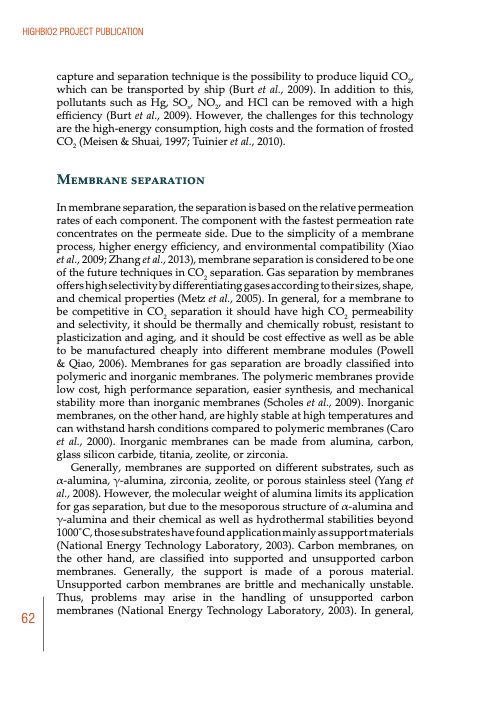
PDF Publication Title:
Text from PDF Page: 063
HIGHBIO2 PROJECT PUBLICATION 62 capture and separation technique is the possibility to produce liquid CO2, which can be transported by ship (Burt et al., 2009). In addition to this, pollutants such as Hg, SOx, NO2, and HCl can be removed with a high efficiency (Burt et al., 2009). However, the challenges for this technology are the high-energy consumption, high costs and the formation of frosted CO2 (Meisen & Shuai, 1997; Tuinier et al., 2010). Membrane separation In membrane separation, the separation is based on the relative permeation rates of each component. The component with the fastest permeation rate concentrates on the permeate side. Due to the simplicity of a membrane process, higher energy efficiency, and environmental compatibility (Xiao et al., 2009; Zhang et al., 2013), membrane separation is considered to be one of the future techniques in CO2 separation. Gas separation by membranes offers high selectivity by differentiating gases according to their sizes, shape, and chemical properties (Metz et al., 2005). In general, for a membrane to be competitive in CO2 separation it should have high CO2 permeability and selectivity, it should be thermally and chemically robust, resistant to plasticization and aging, and it should be cost effective as well as be able to be manufactured cheaply into different membrane modules (Powell & Qiao, 2006). Membranes for gas separation are broadly classified into polymeric and inorganic membranes. The polymeric membranes provide low cost, high performance separation, easier synthesis, and mechanical stability more than inorganic membranes (Scholes et al., 2009). Inorganic membranes, on the other hand, are highly stable at high temperatures and can withstand harsh conditions compared to polymeric membranes (Caro et al., 2000). Inorganic membranes can be made from alumina, carbon, glass silicon carbide, titania, zeolite, or zirconia. Generally, membranes are supported on different substrates, such as α-alumina, γ-alumina, zirconia, zeolite, or porous stainless steel (Yang et al., 2008). However, the molecular weight of alumina limits its application for gas separation, but due to the mesoporous structure of α-alumina and γ-alumina and their chemical as well as hydrothermal stabilities beyond 1000 ̊C, those substrates have found application mainly as support materials (National Energy Technology Laboratory, 2003). Carbon membranes, on the other hand, are classified into supported and unsupported carbon membranes. Generally, the support is made of a porous material. Unsupported carbon membranes are brittle and mechanically unstable. Thus, problems may arise in the handling of unsupported carbon membranes (National Energy Technology Laboratory, 2003). In general,PDF Image | BIOMASS TO ENERGY AND CHEMICALS HighBio2 Project Publication

PDF Search Title:
BIOMASS TO ENERGY AND CHEMICALS HighBio2 Project PublicationOriginal File Name Searched:
978_951_39_5455_0.pdfDIY PDF Search: Google It | Yahoo | Bing
NFT (Non Fungible Token): Buy our tech, design, development or system NFT and become part of our tech NFT network... More Info
IT XR Project Redstone NFT Available for Sale: NFT for high tech turbine design with one part 3D printed counter-rotating energy turbine. Be part of the future with this NFT. Can be bought and sold but only one design NFT exists. Royalties go to the developer (Infinity) to keep enhancing design and applications... More Info
Infinity Turbine IT XR Project Redstone Design: NFT for sale... NFT for high tech turbine design with one part 3D printed counter-rotating energy turbine. Includes all rights to this turbine design, including license for Fluid Handling Block I and II for the turbine assembly and housing. The NFT includes the blueprints (cad/cam), revenue streams, and all future development of the IT XR Project Redstone... More Info
Infinity Turbine ROT Radial Outflow Turbine 24 Design and Worldwide Rights: NFT for sale... NFT for the ROT 24 energy turbine. Be part of the future with this NFT. This design can be bought and sold but only one design NFT exists. You may manufacture the unit, or get the revenues from its sale from Infinity Turbine. Royalties go to the developer (Infinity) to keep enhancing design and applications... More Info
Infinity Supercritical CO2 10 Liter Extractor Design and Worldwide Rights: The Infinity Supercritical 10L CO2 extractor is for botanical oil extraction, which is rich in terpenes and can produce shelf ready full spectrum oil. With over 5 years of development, this industry leader mature extractor machine has been sold since 2015 and is part of many profitable businesses. The process can also be used for electrowinning, e-waste recycling, and lithium battery recycling, gold mining electronic wastes, precious metals. CO2 can also be used in a reverse fuel cell with nafion to make a gas-to-liquids fuel, such as methanol, ethanol and butanol or ethylene. Supercritical CO2 has also been used for treating nafion to make it more effective catalyst. This NFT is for the purchase of worldwide rights which includes the design. More Info
NFT (Non Fungible Token): Buy our tech, design, development or system NFT and become part of our tech NFT network... More Info
Infinity Turbine Products: Special for this month, any plans are $10,000 for complete Cad/Cam blueprints. License is for one build. Try before you buy a production license. May pay by Bitcoin or other Crypto. Products Page... More Info
| CONTACT TEL: 608-238-6001 Email: greg@infinityturbine.com | RSS | AMP |